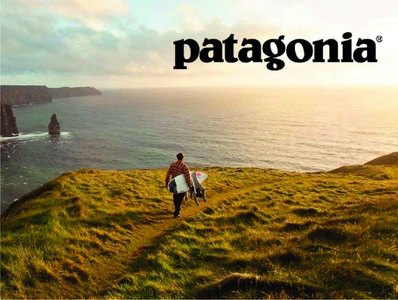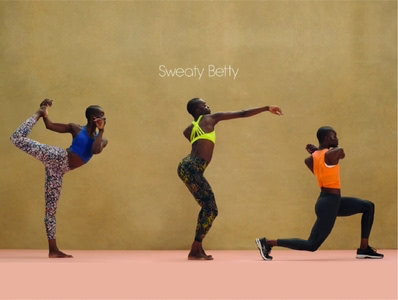Lifestyle brand strategy: The keys to long-term growth
Lifestyle brands don’t just sell a product, they sell a way of life and a set of values. Their branding and marketing efforts endeavour to inspire an emotional connection between their brand and target audience with an emphasis on trust, partnership, and shared values.
More than just selling products or experiences, they want to contribute to their customers’ way of life, and their identity is underpinned by a deep understanding of not only of what their target consumer wants to do, achieve, and feel, but what their lives are missing, and what they need.
Lifestyle brands, be they in the technology, fashion, or food industries, help customers picture an ideal version of themselves and then offer them a means of achieving it. Think of Coca-Cola, Nike or Patagonia, or luxury lifestyle and fashion brand M&S. They go beyond being mere brands: they personify a lifestyle, seamlessly intertwining their products with the everyday lives of their customers. What sets lifestyle brands apart in the market is their ability to convey a lifestyle or ideals that their customers aspire to.
How can a lifestyle brand effectively engage with its target audience?
Consider how you could sell a coffee machine. There are two options:
- Listing the features and benefits of said coffee machine.
- Or, creating a lifestyle around your coffee machine’s typical user – including who’s using it, when they’re using it, and why they’re better for it.
The latter of the two tells a story and offers consumers a glimpse into a way of life—and a community—that they can buy into. It’s about recognising your brand’s cultural relevance, and inviting customers to share join your journey.
To engage this audience, think about what lifestyle means. It boils down to the way in which an individual lives, encompassing their activities, interests, opinions and values. When people embrace a lifestyle, they typically do so to represent who they are. Customers view the items and services they purchase as extensions of who, and what, they believe in.
Lifestyle brands build on this concept and have an incredibly deep understanding of their target consumers’ way of life, not just their demographics, but their psychographics, too. Rather than focussing on who their customers already are—although they know plenty on this—lifestyle brands focus on who they’d like to be and help them achieve it.
Successful lifestyle brands focus on a specific kind of person and work consistently to appeal to that individual, using their voice, image and brand identity to form deep connections with a select few, in the hope that those customers will form a loyal following and become brand ambassadors.
A cohesive strategy is integral to successful branding. A strong and congruent brand story, personality, image, and tone of voice make it easier for customers to buy into your perceived brand value and an ideology that aligns with their own. Using storytelling through marketing, social media and video content, and clever partnerships with public figures or influences can help draw your audience in and build a shared culture around your product. You can even consider highlighting real world experiences with your product to build trust, transparency, and authenticity.
In an age of personalisation, it’s important not to forget the power of data, too. Use data-driven insights to tailor your work and facilitate connections with the right people, in the right places, at the right time.
By placing your customers at the centre of their brand strategy, lifestyle brands inspire long-term loyalty and conversation, which makes it easier to inspire customers to buy other things and support the brand long after they purchase lifestyle products.
Recent trends in lifestyle branding
As lifestyle brands continue to soar, examples of lifestyle brands are not hard to find. But in order to be successful, lifestyle brands need to be flexible and adaptable, capable of adjusting to accommodate the ebb and flow of their consumers’ ever changing desires.
Today’s young consumer demographic are fighters, willing to speak up and preserve a better future for their generation, with a focus on wellbeing, education, environmental concerns, diversity and inclusion. Their consumer considerations are growing to encompass these concerns, and in order to stay emotionally relevant, brands need to mirror these values in their branding and marketing strategies.
of young US customers believe that brands should encourage open discussions about mental health.
In a crowded creative world, brands that offer emotional connection and unique experiences, command presence over those who merely sell products. In case you weren’t aware of it, the demand is there. For example, 68% of young US customers believe that brands should encourage open discussions about mental health, 40% of US Gen Z say that diversity and inclusion is the most important brand value to them when shopping for beauty products, and a whopping 96% of Gen Zers in Singapore are willing to pay a premium for brands they deem transparent. Brands have always been integral to our means of self-representation, but more than ever, consumers are seeking brand lifestyle experiences that tie into their means of self-expression.
Implementing a lifestyle brand strategy
Whether you’re a business owner, copywriter, or marketer, creating a strong, relevant and recognisable brand is essential for growing your business and building a loyal, scalable customer base. Successful lifestyle brands are dependent on cohesive strategies. We can’t say it enough, your brand identity is crucial. Your visual assets, distinctive messaging, digital design, and comms need to deliver a unique and memorable identity that resonates with your audience and perfectly expresses your brand. Here are some tips to get you started:
Do your research:
- Pinpoint your competitors. What is their offering? What will give you a competitive edge?
- Consider what brand values your customers seek out and respond to, and what kind of marketing they like.
- Define your visual assets and consider how they relate to your lifestyle offering.
Know your audience: You want to identify your target market so that you can create the best possible customer experience. What drives them? What excites them? Identify where they shop, where they receive information, as well as the people, things and places that inspire them. Successful brands go beyond compiling demographic data to drive successful marketing campaigns, they dissect every aspect of their audience until they know everything about their way of life.
Know your cultural fit and amplify it: Once you know what kind of lifestyle your consumer is looking for, you can begin to produce products and content that cater to their needs. Know where to best position your brand to solve your customer’s emotional tensions. Understanding your cultural relevance, and how to brand it is key.
Outline your lifestyle offering: What do you want your customers to associate with you? How do you convey this? As a lifestyle brand, you’re here to focus on the why and not the what. Your brand story needs to go beyond features and benefits.
Define your brand personality: Top lifestyle brands have clearly distinguishable personality traits. Having identified your customer base, you should have an idea of how they interact and connect and can adapt your brand tone of voice accordingly. Ultimately, your brand identity should represent the kind of character your customer would want to embrace.
Weave lifestyle into your brand story: You need a vision that your customers can resonate with. Your brand should offer a unique and engaging story that sells the lifestyle you’re offering. Locate a pain point you know your customer wants to fix, and then highlight how your company can help them achieve that.We recommend designing engaging brand guidelines to drive consistency across your content, and align your messaging, visual design, comms, social media marketing, and digital marketing. Your identity – and your lifestyle – should be instantly recognisable across all your channels.
Create your branding: What colours and fonts best convey your lifestyle? How does your brand exterior mirror your brand interior? Think about your verbal and visual identity. If you’re setting up an e-commerce website, experiment with the website layout, to make sure your user experience is representative of your brand. Online and offline – your brand should create a 360-degree experience for users.
Define your marketing channels: What platforms can you use to really drive engagement and capitalise on your cultural relevance? Know where to best engage with your target audience to capture their attention and make high-quality connections.
Eight steps to becoming a successful lifestyle brand
Lead with your lifestyle and embed it: Everything about your brand, from copy to packaging to messaging, should celebrate your lifestyle offering. This is the driver behind everything and should be embedded in every element of your brand.
Make your content about your customers: You don’t need us to tell you how important content marketing is. Your job is to tell them why they need your product, so put their needs, their stories and their aspirations at the heart of everything you do. Look for ways in which you can use your content to connect with your customers. Think about the content you’re putting out there, and how you may even be able to inspire user generated content that speaks to your brand and builds community. Consider blog posts, which are a great way of sharing your knowledge, or videos and podcasts, which are strong tools for connection that offer a far more human touch. Successful lifestyle brands give their followers added value.
Be personal: Lifestyle brands are inherently personable and social. Keep yourself engaged with your target audiences on the platforms they use most often. Social media is a great means of keeping up to date, and staying in conversation with your customer base. Having a dialogue with your consumers is crucial, and this is a great way of authentically showcasing your brand personality and character. Pick social media platforms that your audience like most and meet them where they already are. That way, you can optimize your efforts and get the greatest returns.
Build a community: You need to cultivate evidence that convinces your customers that you’re the key to achieving their identity goals. Influencer marketing and word-of-mouth promotions are great ways of growing a community that is a testament to and consolidates your success. Exercise caution when collaborating with influencers, though, by ensuring they are like-minded people who genuinely represent the values and lifestyle of your brand. Take into account their alignment with your messaging and lifestyle brand marketing, and do some in-depth research before making a commitment.
Be present: As well as being digitally available, you could look to have a physical presence. Physical locations like shops and popups are a great way of building a brand identity through displays, and allow customers to tangibly buy into your brand experience. It’s a great way of drawing attention and gleaning interest in your brand.
Be joinable and shareable: In the consumer-creator era, provide opportunities for your users to co-create, influence and make decisions. Whether it’s through purpose-driven hashtags or webinars – empower and allow your customers and potential customers to take part in your brand.Engagement is the key to your success, and being shareable both in the flesh – and socially is a great way to connect with your following. Influencer marketing is a great for brand endorsement and amplification.
Stick to your values: Branding is all about values. You need to define what you stand for, place it at the heart of your strategy and practice what you preach. Brands gain authenticity by loudly and proudly sharing their values, and continually demonstrating them.
Be consistent: If there’s anything to learn from successful lifestyle brands, it’s that consistency is key. From your illustrations to your digital marketing campaigns, your storytelling needs to be consistent. Remember that emotions are a key selling point, and make sure that your voice is recognisable and harmonious.
How can a lifestyle brand differentiate itself in a competitive market?
Your unique value proposition is key to differentiating your brand in a busy lifestyle market. That means going much deeper than calling out your product features—although they’re incredibly important, too. Without a solid product, you won’t get far even with the right people’s interest.
Emphasise the emotional and cultural drivers behind your brand, tap into aesthetics or values your audience hold dear, and make your statements with your own, unique voice.
People are naturally drawn to community, and you can also reap rewards from investing your energy in brand experiences, letting customers really get to know and involved with your brand. In short, show them the lifestyle you can offer and how your products facilitate it in real time. They can be on or offline; the more unique the events or experiences, the more you will stand out from the crowd, and the more it will get people talking. Think outside the box, invite people in, and they’re sure to want to stick around.
Lifestyle brand examples
Apple and their creative experts: The tech giants understood the assignment. Whether you’re using their products, watching their ads, or visiting their stores, your experience is the same: it’s clean, simple and innovative. Apple products, spaces and marketing strategies embody the brand’s values of being technologically pioneering, creatively conscious, and expertly innovative. Customers who want to be trend-setters, creatives, or have the latest products buy into to Apple’s lifestyle.

Red Bull and their thrill-seekers: They sell their customers a lifestyle, and an energy drink to match. The lifestyle? Adrenaline fuelled, thrill seeking, and extreme sports from Formula 1 to windsurfing. Their tagline ‘Red Bull gives you wings’ sums up their lifestyle offering. Even before the advent of social media, the brand used marketing to reach broad audiences by securing multiple social accounts, having pages on Facebook named ‘Red Bull’, ‘Red Bull Adventure’, ‘Red Bull Snow’, and ‘Red Bull Music’. They also sponsor a wide range of sporting events, like the Red Bull Air Race, motocross, and rally cars. They have cleverly and firmly entrenched themselves in the sporting arena in such a way that they’re inseparable from it; they’re an integral part of that sporting sense of community.

Patagonia and their travellers: A brand dedicated to the outdoors, this love of exploration is instilled across everything they do. Their website acts as a platform where customers can find information, interaction, and activism on topics and issues that align with the brand’s and customers’ values. Concerned with sustainability and their environmental impact, Patagonia provide insights on initiatives committed to reducing impact. Patagonia Action Works is a digital relationship building tool that connects grassroots environmental activists with committed individuals to action and want to make a difference. In the past they have donated 100% of their Black Friday sales to organisations that save the planet. They are devoted to connecting their consumers to a lifestyle that works towards a better tomorrow.

Sweaty Betty and their fitness tribe: You’ll find women sporting Sweaty Betty leggings across the globe. But the brand’s wellness offering goes further than a pair of leggings: they offer free in-store classes to welcome people into their accessible fitness tribe, and we think that’s one of the more unique touchpoints a brand can use to widen their community.

Nike and their players: There’s no avoiding this sporting supergiant, they’re unequivocally the biggest brand in sports apparel and their ubiquity makes them a successful lifestyle brand. Their products are a way of life for fans; how often do you see diehard Nike fans sporting Adidas? They eat, live, breathe, and sweat the brand’s ideals. Behind Nike’s brand strategy is the notion that anyone can be an athlete. It’s a compelling concept that anyone and everyone can connect with. Their strong connection with athletes and use of influencer marketing drives their lifestyle offering and adds brand value. Nike Air Jordans have become an item of in-demand apparel, largely because of the connection to legendary Michael Jordan. Further to that, the feeling of community and connection between everyday people and high profile athletes encourages people to buy into their products and services, allowing everyone to feel a part of the same team. Anyone can ‘just do it’, and Nike are continually supportive of their user base. They don’t just target accomplished athletes, rather they allow all consumers to believe that, with their help, they can achieve their fitness goals. They also use the digital and online space to support athletes of all kinds, with a range of apps and platforms that allow users to track workouts, share progress with friends, and get support from other users via social media.

Harley Davidson and their bikers: This motorbike manufacturer quickly gained something of a cult following. They extended their offering to accommodate all aspects of the adventurer lifestyle: not just the bike, but the apparel, the gear, and the general brand aesthetic. The brand do a great job at creating and selling clothes that embody its brand, turning its wearers into proud brand advocates. So, whether you own a Harley bike or not, you’re still able to participate in the brand’s lifestyle. Not everyone can own a bike, but everyone can wear the clothes. Harley Davidson have carefully crafted and nurtured a community of enthusiastic bikers and brand loyalists. Harley bikes enable customers to buy into a community and a way of life. The brand is extremely good at customer engagement and regularly sponsor bike rallies, donation drives, and other community events. There are initiatives enable them to connect with and engage with their fanbase, build trust, and garner brand loyalty and community.

So, what do you need to know?
In short, lifestyle branding is about brands that understand their consumer base. From a consumer perspective, it’s about connecting to a brand that doesn’t require endless spending. The most important thing? Knowing your audience, understanding what they want to achieve, and helping them get there in a way that builds a lasting connection. Your brand should elicit a bond between business and consumers and work to maintain this through community, cohesion and creative connectivity. It’s all about telling a customer what they want to be, and how your product will help them get there. Pinpoint what lifestyle aspirations your brand would fulfil, and market accordingly.
Your branding establishes an identity that surpasses mere products and services. This distinct identity is what will attract people and turn them into a community of loyal customers. Most importantly, it’s what makes you you. So, invite people to buy into your identity and share in your experiences proudly, and you’ll quickly see the rewards.
How Studio Noel can help build a unique lifestyle brand with long-lasting relevance
At Studio Noel we know that brands mean more than business, and we know that creating a lifestyle brand can be complex and time-consuming.
Whether you just want to learn more about lifestyle branding or are ready to kickstart a lifestyle brand strategy, we’re here to help. We design branding that connects emotionally with your customers and specialise in creating and developing new brands, relaunching tired ones, and adding flex to existing ones.
Get in touch to embark on a lifestyle branding journey – with the right strategy, you’ll see success in no time.